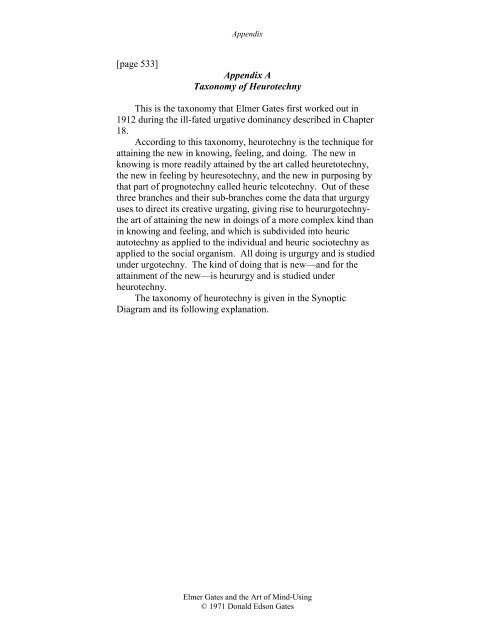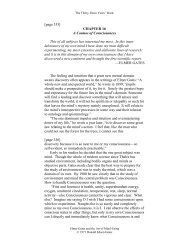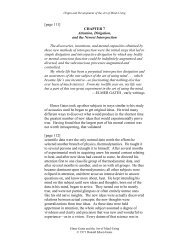A Taxonomy of Heurotechny - ElmerGates.com
A Taxonomy of Heurotechny - ElmerGates.com
A Taxonomy of Heurotechny - ElmerGates.com
You also want an ePaper? Increase the reach of your titles
YUMPU automatically turns print PDFs into web optimized ePapers that Google loves.
Appendix<br />
[page 533]<br />
Appendix A<br />
<strong>Taxonomy</strong> <strong>of</strong> <strong>Heurotechny</strong><br />
This is the taxonomy that Elmer Gates first worked out in<br />
1912 during the ill-fated urgative dominancy described in Chapter<br />
18.<br />
According to this taxonomy, heurotechny is the technique for<br />
attaining the new in knowing, feeling, and doing. The new in<br />
knowing is more readily attained by the art called heuretotechny,<br />
the new in feeling by heuresotechny, and the new in purposing by<br />
that part <strong>of</strong> prognotechny called heuric telcotechny. Out <strong>of</strong> these<br />
three branches and their sub-branches <strong>com</strong>e the data that urgurgy<br />
uses to direct its creative urgating, giving rise to heururgotechnythe<br />
art <strong>of</strong> attaining the new in doings <strong>of</strong> a more <strong>com</strong>plex kind than<br />
in knowing and feeling, and which is subdivided into heuric<br />
autotechny as applied to the individual and heuric sociotechny as<br />
applied to the social organism. All doing is urgurgy and is studied<br />
under urgotechny. The kind <strong>of</strong> doing that is new—and for the<br />
attainment <strong>of</strong> the new—is heururgy and is studied under<br />
heurotechny.<br />
The taxonomy <strong>of</strong> heurotechny is given in the Synoptic<br />
Diagram and its following explanation.<br />
Elmer Gates and the Art <strong>of</strong> Mind-Using<br />
© 1971 Donald Edson Gates
Appendix<br />
[pages 534 & 535]]<br />
Elmer Gates and the Art <strong>of</strong> Mind-Using<br />
© 1971 Donald Edson Gates
Appendix<br />
[page 536]<br />
(Adapted.)<br />
<strong>Heurotechny</strong> is the general name for our special understanding<br />
<strong>of</strong> the pre-psychurgic stage <strong>of</strong> originality, and for the psychurgic<br />
stages <strong>of</strong> the following: heuretotechny, or discovering;<br />
heuresotechny, or esthesiating; misthokerdics, or livelihood and<br />
business; heuremotechny, or inventing; poiotechny, or esthetic<br />
creating; prognotechny, or prejudging values; and for sociotechny,<br />
or dealing with persons.<br />
Heuric autotechny is <strong>com</strong>prised <strong>of</strong> four arts—misthokerdics,<br />
heuremotechny, poiotechny, and prognotechny; all are degrees and<br />
kinds <strong>of</strong> creating. Heuremotechny is more creative than<br />
misthokerdics, less than poiotechny, but all are creative. When a<br />
man begins to make a living, he is creatively productive; when he<br />
invents, he enlarges his creative power and results; when his<br />
creative imagination gives new fine arts, he be<strong>com</strong>es still more<br />
creative; and when he prognoses, still more. Invention is not<br />
synonymous with creative work as <strong>of</strong>ten supposed, but is a degree<br />
<strong>of</strong> creation.<br />
Misthokerdies is used by heuremoretics just as inventions are<br />
used as data for poiotechny, which the higher creative work uses as<br />
tools. A creative artist or organizer uses inventions and persons as<br />
mere materials by which he gives embodiment to his conceptions<br />
and aims. In like manner heuric sociotechny is creative. One may<br />
apply the processes <strong>of</strong> heuric autotechny and <strong>of</strong> heuric sociotechny<br />
to heuretotechny and augment knowledge and do creative work <strong>of</strong><br />
the highest order, but discovery in itself is not invention.<br />
One may invent a wheel and discover a new chemical, but the<br />
former cannot be discovered nor the latter invented. A machine<br />
may be invented; a fact or law has to be discovered, a principle<br />
insighted. The mental processes are different. Heuretotechny is<br />
the finding <strong>of</strong> a new thing, as when an explorer finds a new animal<br />
or plant. The exploration may<br />
[page 537]<br />
require courage, skill, and money, but the mental process <strong>of</strong><br />
finding a new thing is the simplest kind <strong>of</strong> heuretotechuy. To<br />
discover a new fact requires more mental ability, a new law, still<br />
more; to arrive at a true and new principle, still more. New<br />
insights require sophic ability. Heuretotechny creates science; and<br />
when especially applied to it is epistemics.<br />
Elmer Gates and the Art <strong>of</strong> Mind-Using<br />
© 1971 Donald Edson Gates
Appendix<br />
Heuresotechny studies the esthesias. A new one may rise in a<br />
person by growth: he cannot discover it except in the sense <strong>of</strong> an<br />
explorer <strong>of</strong> the inner world who by introspection detects an<br />
esthesia <strong>of</strong> which he previously was unaware. Heuresotechny may<br />
develop new esthesias in a person or train him to be<strong>com</strong>e aware <strong>of</strong><br />
more <strong>of</strong> them, may normalize and intensify them, and teach how to<br />
utilize them.<br />
The new in cognition (intellection, introspection, esthesis,<br />
urgation) and the new in cognosis and the new in sophics<br />
(philosophy and religion) are discovered by different kinds <strong>of</strong><br />
discovering; and in each the new in the cognic, esthic, and urgic<br />
branches is discovered by different modes. All these differences,<br />
hard to define, are fully recognized in this terminology. Thus there<br />
are the cognitive, cognostic, and sophic kinds <strong>of</strong> heurotechny; and<br />
<strong>of</strong> each kind there are three modes. Heuretotechny is the cognic<br />
mode, heuresotechny the esthic mode, and heururgotechny the<br />
urgic mode. Simple, is it not! But it has gradually be<strong>com</strong>e so after<br />
forty years <strong>of</strong> constant improvement.<br />
The distinction between the process <strong>of</strong> invention and the<br />
process <strong>of</strong> discovery is <strong>com</strong>plete: “heuremo” means invention, and<br />
“heureto” means discovery. The seven kinds <strong>of</strong> creative work are<br />
different. Heuretotechny discovers; heuremotechny takes the<br />
discoveries and all things and knowledge and invents.<br />
Heuresoretics leads to new esthesias; heuresoremics teaches how<br />
best to enjoy them. Poiotechny uses all these urgids creatively<br />
according to esthetic needs. In heuremotechny, science is the slave<br />
<strong>of</strong> invention; in heuretotechny, invention is the slave <strong>of</strong> science;<br />
but the two arts are never entirely disassociated. In the<br />
[page 538]<br />
long run science is master. Poiotechny uses both science and<br />
invention as the tools with which to achieve the desires that are<br />
normalized and trained by heuresotechny. Creative work aids both<br />
science and invention. Every step in invention involves some<br />
discovering, and every step in discovery some inventing, and in<br />
both there may be more or less creative work.<br />
Misthokerdics is that branch <strong>of</strong> heuric autotechny dealing with<br />
livelihood and business. The making <strong>of</strong> a livelihood without<br />
carrying on a business for pr<strong>of</strong>it is misthics. The carrying on <strong>of</strong> a<br />
business for pr<strong>of</strong>it is kerdics.<br />
Heuremotechny, the art <strong>of</strong> inventing, has three divisions.<br />
Heuremics deals with inventing as a mode <strong>of</strong> ingenuity.<br />
Heuremoheuretics is inventively-directed scientific research for<br />
Elmer Gates and the Art <strong>of</strong> Mind-Using<br />
© 1971 Donald Edson Gates
Appendix<br />
special lines <strong>of</strong> invention. (Heuremics will experimentally try<br />
everything to make a better adhesive, but heuremo-heuretics will<br />
study the chemistry <strong>of</strong> adhesives and the physical problems<br />
involved in cementation, and apply that special knowledge to<br />
making an adhesive.) Heureto-heurermics deals with scientific<br />
research from a more purely scientific interest; it applies invention<br />
directly to methods <strong>of</strong> scientific research, hoping to discover the<br />
conditions <strong>of</strong> human welfare in that domain.<br />
The stage <strong>of</strong> discovery is Heuretotechny, and is <strong>com</strong>prised <strong>of</strong><br />
four divisions. 1) Heuretics is carried on for the advancement <strong>of</strong><br />
science and sophics or as a predilective passion. It is subdivided<br />
into heurognition (original intellectuating and introspection) as<br />
well as heurognosis and heurosophics. The heurist is looking for<br />
contributions to scientifically-organized knowledge, for insights<br />
and generalizations in philosophy, and for impulses and conduct as<br />
contributions to his conscious relatedness (religion). Scientific<br />
research and philosophic insighting be<strong>com</strong>e a religious duty and<br />
worship; art and industry and science and sophics are his religion.<br />
2) In heuretoremics the scientist applies scientific knowledge,<br />
sophic insights, and religious feeling and impulses to the<br />
[page 539]<br />
improvement <strong>of</strong> the arts <strong>of</strong> inventing and discovering and creating.<br />
3) ln heuremoretics the scientist applies scientific knowledge,<br />
sophic insights, and religious feelings and impulses and an<br />
improved art <strong>of</strong> inventing, discovering, and creating to training<br />
and organizing inventors. Inventors as assistants be<strong>com</strong>e the<br />
scientist’s tools <strong>of</strong> research and instruments <strong>of</strong> revelation. 4)<br />
Heuristics studies heurists (inventors and discoverers and creative<br />
workers generally) just as a scientist studies any other natural<br />
phenomena, for science’s sake. Likewise the scientist studies the<br />
Achieved Results <strong>of</strong> heurists (individual and <strong>com</strong>parative<br />
heuristology), and organizes them.<br />
Heuresotechny is the art by which the individual is awakened<br />
to esthesias <strong>of</strong> which he would not have be<strong>com</strong>e aware, and <strong>of</strong><br />
developing new esthesias in the individual and the race. It is for<br />
attaining the desirable cunesthesias and avoiding or minimizing the<br />
undesirable kakesthesias that all cognitive urgation is carried on,<br />
and it is solely as a guide to this urgation that cognitive knowledge<br />
has value. To determine what are the normal esthesias for any race<br />
is necessarily the first step in the safe and sane organization <strong>of</strong> the<br />
heurotechnical work <strong>of</strong> that race. Heuresotechny is subdivided<br />
into heuresoretics, the art <strong>of</strong> awakening and developing new<br />
esthesias; heuresoremics, the art <strong>of</strong> inventing esthesic arts (fine<br />
Elmer Gates and the Art <strong>of</strong> Mind-Using<br />
© 1971 Donald Edson Gates
Appendix<br />
arts) and devices relating thereto; and heuresics, the sophic<br />
handling <strong>of</strong> this subject.<br />
Poiotechny (synthetic heurotechny) is the art by which the<br />
heurist may more happily and successfully use his abilities, money,<br />
inventions, discoveries, and his esthesias in functionating his<br />
whole person, periperson, and organism in creative work, as in the<br />
fine arts or personurgy. Poiotechny is <strong>com</strong>prised <strong>of</strong> poietics, the<br />
principles and laws <strong>of</strong> creative esthetics; heuremo-poietics, the<br />
application <strong>of</strong> invention to creative esthetics; poio-heuremics, the<br />
application <strong>of</strong> creative esthetics to inventing; heureto-poietics, the<br />
application <strong>of</strong> the art <strong>of</strong> discovering to creative esthetics;<br />
[page 540]<br />
poio-heuretics, the application <strong>of</strong> creative esthetics to discoveries;<br />
heureso-poictics, the application <strong>of</strong> heuresotechny to creative<br />
esthetics; and poio-heuresics, the application <strong>of</strong> poiotechny to<br />
heurmtechny. Leisure is needed for the best poiotechny. The<br />
creative impulse arises out <strong>of</strong> familiarity with a subject; its truth<br />
and utility must be known for a long time before the mind can<br />
handle it estheto-creatively. The most efficient work in any branch<br />
<strong>of</strong> urgotechny arises from the esthetic impulse, and this is<br />
especially true <strong>of</strong> heurotechny; but estheto-creative work in heurics<br />
requires a dominancy. Every urgurgy is most efficient when it is at<br />
the same time a poiurgy.<br />
Prognotechny considers the principles and methods <strong>of</strong><br />
foreknowing, or prognosis. Improvisation is a modus operandi <strong>of</strong><br />
arriving at new purposes, and speculation a way <strong>of</strong> arriving at new<br />
insights. When prognosis is applied to heuremotechny, it is<br />
prospection; to heuretotechny, it is pregnosis; and to<br />
heuresotechny, it is prerexis.<br />
Heuric sociotechny is the application <strong>of</strong> heurotechny to the<br />
social group as if it were an individual—the art <strong>of</strong> more skillfully<br />
using and more efficiently utilizing the social organism, and <strong>of</strong> the<br />
social organism’s utilizing the individual. It is cooperative and<br />
synmentic. It may be extended to a World Work—a movement or<br />
line <strong>of</strong> work carried on throughout the world to bring the facilities<br />
and best minds to bear on that work.<br />
[End <strong>of</strong> book]<br />
Elmer Gates and the Art <strong>of</strong> Mind-Using<br />
© 1971 Donald Edson Gates






![[page i] Elmer Gates and the Art of Mind-Using ... - ElmerGates.com](https://img.yumpu.com/35274485/1/190x245/page-i-elmer-gates-and-the-art-of-mind-using-elmergatescom.jpg?quality=85)
